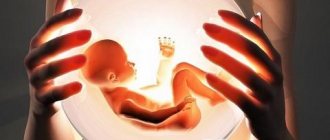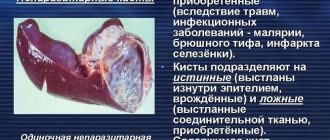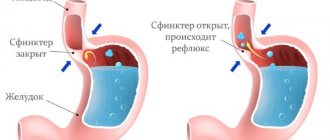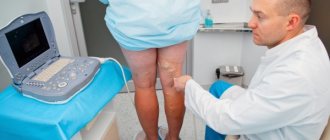Palpitations - a feeling that the heart is beating too quickly or is beating too hard - is a reason to consult a doctor.
Heartbeat
is a patient complaint about the subjective sensation of a rapid, arrhythmic or heavy heartbeat. Normally, we do not notice our heartbeat. But any deviation from the norm becomes immediately noticeable. Patients typically describe palpitations as the following: the heart pounding too hard (or “loudly”) in the chest, the heart “jumping” out of the chest, pounding, “jerking,” “spinning,” or “fluttering.” Increased heartbeat may be accompanied by a feeling of pulsation in the neck, temples, pit of the stomach or fingertips. Palpitations may also be accompanied by tinnitus, pain in the heart area, a feeling of tightness in the chest or difficulty breathing. Such symptoms may indicate heart pathology, but in most cases, complaints of increased heartbeat with accompanying symptoms, instrumental studies do not reveal signs of heart damage.
Palpitations should be distinguished from tachycardia. Tachycardia
– this is an objective increase in heart rate. The normal heart rate for an adult at rest is 60-80 beats per minute. If more than 90 beats per minute are recorded, then tachycardia is diagnosed. However, the patient may not feel that his heartbeat is rapid.
Causes of rapid heartbeat
Normally, at rest, a person should not feel his heart beating. An increase in heart rate above 100 beats per minute is called tachycardia.
If a person is healthy, then the reasons for its occurrence may be as follows:
- Stressful situations in which a person begins to worry greatly.
- Intense physical activity.
- Low oxygen content in the inhaled air.
- High body temperature. An increase of even 1 degree causes the heart to beat faster.
All of these factors are not indicators of heart disease. The increase in its rhythm in this case is regarded as a physiological phenomenon.
Hormonal imbalances can cause increased heart rate. This is true for women during menopause.
Sometimes the cause of increased heart rate is food allergies, eating large amounts of food, or consuming drinks with high levels of caffeine.
Increased heart rate caused by non-pathogenic causes is not accompanied by symptoms such as:
- Blood pressure does not increase.
- My heart doesn't hurt. There is no feeling of discomfort in the chest.
- A person does not feel dizzy, his vision does not go dark.
- The person does not lose consciousness.
- The person does not have panic attacks.
If the heart begins to beat faster due to the influence of external factors on the body, then normalization of its rhythm occurs quickly, literally in a few seconds. For this to happen, you just need to calm down.
If a person plays sports, then he needs to control his own pulse and be able to measure the maximum possible heart rate. To do this, you need to subtract the number of years from the number 220. For example, if a man is 40 years old, then during sports the heart rate per minute should not exceed 180 beats.
When a person generally moves little, his heart rate will increase under any load, for example, when he rises sharply from a place or when he changes his body position. To prevent this from happening, you need to gradually increase your physical activity and play sports.
Video: medical cardiologist about rapid pulse:
Possible consequences
Complications of rapid pulse are caused by hemodynamic and blood pressure disorders.
Among them:
- Heart attack. The most likely outcome of untreated tachycardia. It consists of an acute malnutrition of the middle muscular layer of the organ. It develops rapidly and can lead to cardiogenic shock or death without prior symptoms.
- Stroke. Similar condition. Consists of acute necrosis of brain structures. There are two types: ischemia (malnutrition) and hemorrhage (rupture of a blood vessel with the appearance of a hematoma). The second option more often ends in death or severe disability as a result of the presence of an additional pathological factor: compression of brain tissue.
- Cardiogenic shock. A sharp, critical drop in blood pressure. It has a significant mortality rate: out of 10 victims, 9 die, that is, the probability of death is 90% or more. Even if body functions are restored, few people cross the 5-year mark.
- Heart failure. Not accompanied by any warning signs. It occurs suddenly and leads to rapid death. Possible even in apparently healthy patients. When carrying out resuscitation measures, there is hope for the patient to return to life, but this scenario is also unlikely.
- Thromboembolism. It becomes the result of the destruction of formed blood cells, platelets and their clumping into a single “lump”. This structure clogs the blood vessels, completely or partially. Hence the likelihood of acute circulatory disorders in the tissues. Occlusion of the pulmonary artery and cardiac structures is fatal.
- Sudden fainting. In threatening conditions it has an unfavorable effect, because an attack is possible while climbing stairs, crossing the road, or driving a car.
- Heart failure. The result of organ overload. It is fully formed after 1-4 months.
Increased heart rate ends in shock, heart attack, stroke, and other consequences in 15-20% of cases, provided that it lasts for more than 2 months in general. Carrying out complex treatment (etiotropic + symptomatic) the value drops sharply and is only 3-5%.
When is a rapid heartbeat a sign of illness?
A rapid heartbeat may indicate certain pathologies in the cardiovascular system or hormonal background.
These include:
- Manifestation of myocardial infarction, or pre-infarction condition.
- Myocardial dystrophy.
- Vegetative-vascular dystonia at an early age. In this case, control over vascular tone is lost, which leads to increased heart rate.
- Sinus tachycardia.
- Blood pressure surges, high blood pressure.
- Cardiosclerosis.
- Congenital and acquired heart defects.
- Heart blockades.
- Neurological diseases.
- Bleeding.
- Dehydration of the body.
- Hyperthyroidism of various nature.
- Diseases of the digestive system: gastritis, ulcers, diaphragmatic hernia, etc.
- Diseases of the respiratory system: obstructive bronchitis, bronchial asthma. Attacks of rapid heartbeat are often observed in patients taking drugs such as: Berodual, Salbutamol, Berotek, etc.
- Intoxication of the body.
- Anemia.
- Acute infection or purulent pathology.
- Tumors of the brain and mediastinal system.
- A state of shock that can develop after an injury, against the background of bleeding, after a burn, etc.
There are symptoms that accompany rapid heartbeat that occur with various pathologies of the body:
- The person begins to feel short of breath and develops shortness of breath.
- He gets tired quickly.
- The person often experiences dizziness.
- You may experience a feeling of nausea.
The fact that palpitations are not a physiological reaction of the body, but a pathological symptom, will be indicated by the sudden onset of an attack and its rapid completion. During this period, heart rate can reach 220-230 beats per minute.
If a woman is pregnant, then her heart rate normally increases by 10-15 beats per minute.
Prevention of myocardial problems
To prevent your heart from bothering you with loud pulsations, it is important:
- try to maintain a normal weight, as obesity overloads the myocardium and blood vessels;
- even if you follow a diet, include vitamins and foods containing magnesium and potassium;
- train your heart through sports (walking, running, cycling), but not to the point of exhaustion;
- If you have a cold, do not self-medicate, do not carry it on your feet;
- do an ECG once a year;
- be less nervous.
Strong pulsation is not a disease, but a manifestation of a problem. And you can’t ignore it, even if it bothers you from time to time. The sooner you take care of yourself, the higher the chance of restoring your previous quality of life.
Symptoms of heart palpitations
Symptoms of rapid heartbeat largely depend on the cause that caused it, as well as on the individual characteristics of the body. Some patients describe this condition as mild discomfort in the chest, while others describe it as intense heartbeats, accompanied by jumps, revolutions, stops, etc. If the pulse quickens to 100 beats per minute or higher, then people indicate a feeling of fluttering in the chest. In some cases, people's heart beats quickly, but they do not notice it.
Increased heart rate occurs as a seizure. It can last a few seconds or even several days. It all depends on the cause of the violation.
What symptoms are associated with rapid heartbeat?
With VSD, in addition to a rapid heartbeat, a person will be in a heightened psycho-emotional state. His tearfulness increases and he may show aggression. Somatic signs of the disease are headache, increased sweating, nausea and vomiting, low blood pressure. Often in such patients, a rapid heartbeat is accompanied by a panic attack.
With pathologies of the thyroid gland, a rapid heartbeat will be accompanied by increased sweating, trembling in the body, weight loss against the background of increased appetite. Patients develop exophthalmos.
Dangerous symptoms
Sometimes a rapid heartbeat requires immediate consultation with a doctor, as it poses a direct threat to life. You should immediately call a medical team if a person experiences pain in the chest, between the shoulder blades, or cold sweat against the background of tachycardia, or shortness of breath. Such signs indicate myocardial infarction.
Left ventricular heart failure of the acute type is accompanied by increased heart rate, suffocation, shortness of breath, and the appearance of pink foam at the mouth. Most often, an attack occurs at night, when blood stagnates in the veins of the lungs, edema and cardiac asthma develop.
If the heart beats irregularly but frequently, this may indicate atrial fibrillation or sick sinus syndrome. During an attack, the patient may lose consciousness. The danger of this pathology is reduced to cardiac arrest.
You should immediately call a medical team if ventricular tachycardia and frequent ventricular extrasystoles develop. These pathologies are manifested by rapid heartbeat, increased sweating, darkening of the eyes and severe shortness of breath. The patient begins to choke.
So, increased heart rate with shortness of breath, heart pain and other pathological symptoms is a reason to consult a doctor. In some cases, medical assistance must be urgent.
Development mechanism
Weakness, dizziness and rapid heartbeat have a common development mechanism. Due to certain irritating factors, tachycardia occurs. As the heart rate increases, hemodynamic disruptions occur, which impair the nutrition of the brain and other tissues. The severity of manifestations depends on individual tolerance, the condition of the blood vessels, the degree of maintaining the constancy of cerebral (brain) blood flow and the contractility of the heart.
If there is a sudden interruption in cerebral blood supply, the patient will feel dizzy. If the failure lasts a couple of minutes, loss of consciousness is possible. The feeling of weakness occurs due to frequently recurring attacks of tachycardia, against the background of which oxygen starvation of the tissues manifests itself.
Diagnosis of heart palpitations
If increased heart rate is a physiological phenomenon, the person does not require examination. Pathological tachycardia is a reason for undergoing diagnostics.
The following techniques can help determine the reasons for the acceleration of heart rate:
- ECG.
Determines heart rate at the time of diagnosis.
- Daily monitoring of heart rate using Holter.
This study allows us to identify how the heart rate changes during physical activity, at rest, with a slight increase in activity, and during sleep.
- Ultrasound of the heart, echocardiography.
These studies can identify abnormalities in the functioning of the heart.
When a patient arrives for an appointment, their blood pressure level is measured. Bicycle ergometry is also possible. in this case, the person should exercise on an exercise bike. Special equipment will calculate his heart rate.
A rapid heartbeat can indicate not only heart disease, but also other pathologies of internal organs. Therefore, you will need to donate blood for a biochemical analysis to determine the thyroid hormones in it.
Who "commands" the heart
The main one who decides how often the heart will contract is the autonomic nervous system, which does not depend on our consciousness and regulates the activity of all internal human organs. Sympathetic nerves approach the heart, which are responsible for accelerating its activity in times of danger, during physical exertion and excitement. Next to them are the endings of our main parasympathetic nerve - the vagus. On the contrary, it reduces cardiac contractility. The vagus nerve has its own ri: its maximum activity occurs at 3-4 a.m., when the minimum pulse is recorded.
Nerve fibers communicate their command to the main “command post” of the heart – the sinus node. This is a cluster of modified muscle cells that can produce and conduct their own electrical impulse. From the sinus node, located in the right atrium near the blood vessels, a “path” of similar cells that conduct the generated impulse stretches along the entire heart. This is the conduction system of the heart.
Since the heart is an incredibly important organ, its conduction system is equipped with powerful protection: there are several other sinus nodes that are also able to generate an impulse. Normally, they are “silent” and start their own work only when they have not waited for the next command from the sinus node, which must deliver at least 65 pulses per minute, so that at least 0.8 seconds pass between them. All this work is calculated so that the “command” spreads from the atria along the interventricular septum - along one path, which then bifurcates and goes to each of the ventricles at the same speed so that the ventricles contract simultaneously. Normally, there are “roundabout ways” for conducting impulses, but they must be silent.
The cells of the conduction system of the heart lie in the thickness of the cells that ensure its contraction, that is, in the thickness of the myocardium. If the myocardium has been damaged by inflammation, if a piece of it at one of the key points of the conduction system has died during a heart attack, the heart rhythm is disturbed. This may look like a blockade of the impulse at some level, “turning on” nodes of lower order, or “disobedience” of the impulse, which goes not only along the main, but also along additional paths.
You also need to know that the impulse generated in any of the nodes is not the same kind of electricity that powers electrical appliances. It involves the opening of cellular channels first in one, then in another cell, as a result of which sodium changes, enters the cell, and potassium leaves it. Accordingly, if the composition of potassium and sodium outside the heart cells is disrupted, it will be very difficult to generate an impulse. The same thing will happen if such a transfer of ions cannot be ensured energetically, which is what some hormones (mainly those of the thyroid gland), vitamins and enzymes do.
Thus, the heart rate may increase in the following cases:
- imbalance between parts - sympathetic and parasympathetic - of the autonomic nervous system;
- pathologies of that part of the brain from which both parts of the ancient, autonomic system originate;
- interference in the path of the “conducting path”: inflammation of adjacent heart cells or their death (that is, replacement by scar) when they cannot properly respond to the impulse;
- intoxication, affecting both commands from the autonomic system and the balance of electrolytes;
- congenital disorders of the “path” along which the impulse goes;
- imbalance on the part of metabolic processes that should ensure normal functioning of the heart: with diseases of the endocrine organs, disturbances in the amount or ratio of magnesium, calcium, potassium and sodium in the blood, a decrease in the amount of vitamins, mainly B-group.
The most common reasons are:
- intoxication due to any inflammatory diseases, including those caused by poor nutrition (pancreatitis, cholecystitis);
- thyroid diseases;
- activation of additional pathways;
- activation of several nodes to generate impulses;
- “circling” the pulse generated in one of the nodes along the conductive system;
- imbalance of potassium, calcium and magnesium;
- in children and adolescents - an imbalance between the two parts of the autonomic system, when examination makes it possible to diagnose vegetative-vascular dystonia.
First aid for palpitations
If a person’s heart rate increases and the number of beats per minute exceeds 100, then you should not hesitate to call a medical team.
While the ambulance is on the way, you can take the following actions:
- The patient can put his hands in cold water. Alternatively, you can wipe your face with a piece of ice.
- You need to try to calm the person down.
- It is necessary to ensure a flow of fresh air. To do this, you should open the window, unfasten your collar, and remove from your neck all objects that may restrict breathing.
- You can offer a person 25-30 drops of Corvalol, Valoserdin or Valocordin to choose from.
- If possible, you should measure the person's pulse and blood pressure.
- The person should take a deep breath and hold it for a few seconds. It is important at this time to try to expand the chest. Then you need to exhale slowly. Repeat this exercise at least 6 times.
- You can cough or try to induce a gag reflex.
- Use your fingers to press on the eyeballs. Pressure must be applied for 10 seconds, after which it is released. Repeat pressing 10-15 times.
These recommendations can improve a person’s well-being and slightly reduce their heart rate. The patient must be examined by a physician. The doctor will determine the cause of the disorder and prescribe treatment.
In order for the doctor to understand what is happening to the patient, he must receive answers to the following questions:
- Is this the patient’s first attack, or do they recur regularly and with what frequency?
- How long does the attack last?
- What time does the attack most often occur?
Treatment is prescribed only after the causes of the rapid heartbeat have been established.
Rapid heartbeat is not an independent pathology, that is, it does not occur on its own. An attack of tachycardia is caused by various diseases that can be identified during diagnostic measures. If such crises occur frequently, the doctor may recommend taking adrenergic blocking drugs or calcium channel blockers.
Additional recommendations
When starting a workout in the gym, be sure to do a short warm-up.
If your heart rate begins to increase during exercise, pause the exercise and take a few breaths. Take a warm shower and finish with a cup of green tea. In the future, increase physical activity gradually. When rapid heartbeat is a consequence of fatigue, insomnia or a stressful situation, you can include valerian, motherwort, lemon balm and St. John's wort in a soothing collection.
Black currants, rose hips and honey are good for normalizing the contractions of the heart muscle. If possible, these products should be present in the daily diet.
Do not use medications without consulting a doctor and carefully read the instructions that come with them.
To normalize heart rate and as a preventive measure, the best remedy is a correct lifestyle. Give up bad habits, maintain your sleep and diet. Fatty, spicy foods, alcohol, coffee, smoking are the first enemies for people predisposed to increased heart rate. And definitely move more. Without the opportunity to actively engage in physical exercise, take walks, and while resting, massage your shoulder and knee joints.
Having mastered primary knowledge of how to lower the pulse at home, without having the necessary medications, everyone will be able to quickly help themselves and a loved one or reduce the risk of an attack of tachycardia.
howtogetrid.ru
Treatment methods
To cope with the disease, it is necessary not only to take medications, but also to quit smoking, lead a healthy lifestyle, and play sports. The person will need to monitor blood pressure and blood cholesterol levels.
During an attack of rapid heartbeat, you need to take a sedative. This could be Valerian, Motherwort, Validol, Hawthorn, Valocordin, Corvalol. A person needs peace, both physical and psychological.
Medicines that the doctor may prescribe:
- Sedatives.
They can be based on plant components (Persen, Novo-Passit). Synthetic drugs have a pronounced effect: Phenobarbital, Diazepam.
- Antiarrhythmic drugs:
Verapamil, Flecainide, Adenosine, etc.
Sedatives are prescribed to patients with vegetative-vascular dystonia. They reduce the number of attacks and stabilize the nervous system.
Antiarrhythmics can be taken only after medical consultation. The drugs are selected by a cardiologist, as they not only have a therapeutic effect, but also have a number of side effects.
If a patient is diagnosed with ventricular tachycardia, then medications such as Obzidan and Lidocaine are recommended. If they do not stop the attack, then treatment is carried out with electrical impulses.
In addition to a cardiologist, a person will need to consult a neurologist. Sometimes patients are prescribed not only sedatives, but also psychotherapy, for example, hypnosis or massage sessions. To increase the tone of the vagus nerve, eye massage is indicated.
Severe pathologies that lead to rapid heartbeat require surgical intervention:
- Pheochromocytoma, thyrotoxicosis.
For these diseases, the doctor may remove both the tumor and part of the thyroid gland.
- Cardiac surgery treatment
required for patients with heart defects and coronary artery disease.
Video: Live healthy! Frequent heartbeat. How to calm your heart?
Assisted therapy at home
You cannot treat palpitations on your own. However, if a person is predisposed to such attacks, you need to be able to help yourself.
In addition to taking medications, you can use the following recommendations:
- Lead a measured lifestyle.
- Avoid stress and allocate enough time for rest.
- Do physical therapy.
- Do exercises every morning.
- Eat right, avoid fatty foods, do not drink tea, carbonated water, coffee, chocolate.
- Take a contrast shower and soak your feet.
- Bring your body weight back to normal.
- Take vitamins.
If a person is prone to increased heart rate, which occurs like attacks, it is necessary to avoid excessive physical exertion. They can lead to the formation of blood clots.
Diet is an integral component of treatment. Every day a person should eat fortified foods: vegetables, fruits, dried fruits, nuts. Be sure to include dried apricots, fresh watermelons, potatoes, currants, beets, raspberries, and citrus fruits in your diet.
After medical consultation, it is permissible to take magnesium supplements. In case of a sudden attack, you should lightly massage the right side of the neck, in the place where the carotid artery passes. This will prevent heart palpitations and prevent a crisis.
Safe folk remedies
Tea with anise (100 grams of raw material per 200 ml of water, brew, drink half a glass per day). A decoction of valerian, motherwort, mint, lemon zest, St. John's wort (prepared as a simple tea). Drink 1 glass per day.
Lifestyle changes.
- Quitting smoking and alcohol.
- Optimizing physical activity. 2 hours of walking per day.
- Drinking regime - 1.8 liters.
- Salt - no more than 7 grams.
Diet is a separate issue.
| Can | It is forbidden |
| Vegetables and fruits | Chocolate |
| Boiled eggs | Fast food in any form, canned food, semi-finished products |
| Natural sweets (honey) | Sugar in large quantities |
| Lean meat and soups based on it | Fatty meats, smoked and fried foods |
| Cereal porridge | Baking |
| Wholemeal bread | Tea |
| Dairy products | Coffee |
| Oils: vegetable and butter | Energy |
. You can’t overeat, it’s better to eat small meals. Minimum salt. You should also not eat at night (2-3 hours before rest).
Treatment table No. 10 is shown. Diet correction is carried out under the supervision of a nutritionist or endocrinologist.
Is it possible to quickly stop a heart attack?
To quickly deal with palpitations, you can use two simple recommendations:
- Immerse your face in cold water.
The heart begins to beat less frequently as the body cools down. This is an effective method that is accessible to most people. If you don’t have a container on hand to collect liquid, you can simply rinse your face with cool water or wipe it with pieces of ice.
- Perform the Valsalva maneuver.
The person will need to take a deep breath and tense their abdominal muscles. The nose is pinched with two fingers, the mouth and eyes are closed. In this state, you need to try to exhale. At the same time, the abdominal muscles are tensed.
All these methods can be used in cases where increased heart rate was caused by physiological factors. If chest pain appears during an attack and shortness of breath develops, you should seek help from a doctor.
Author of the article:
Molchanov Sergey Nikolaevich |
Cardiologist Education: Diploma in Cardiology received from Perm State Medical University named after. I. M. Sechenova (2015). Here I completed my postgraduate studies and received a diploma in Cardiology. Our authors











